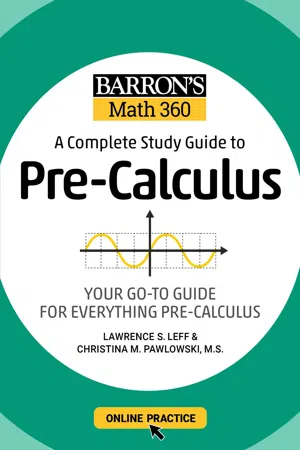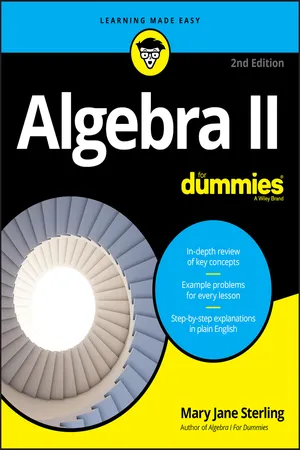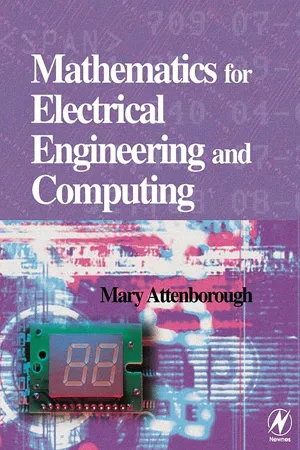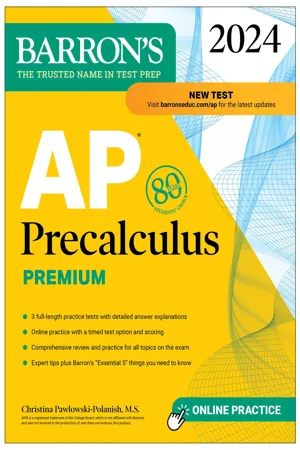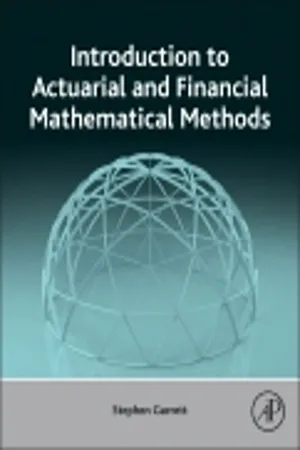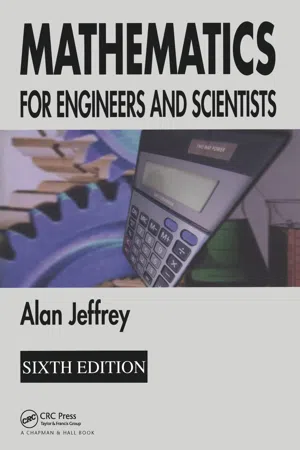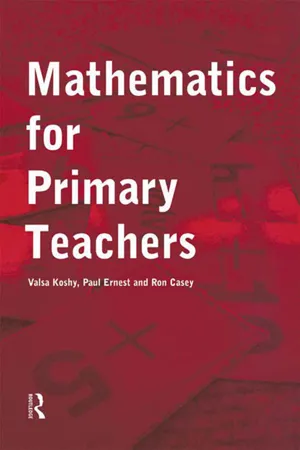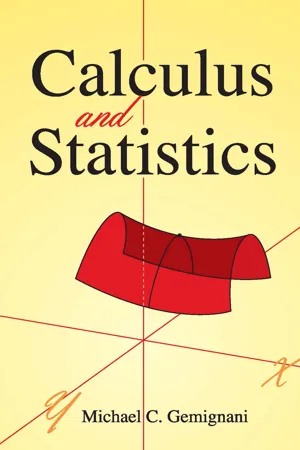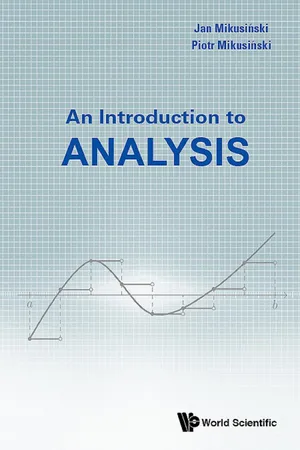Mathematics
Geometric Sequence
A geometric sequence is a sequence of numbers where each term after the first is found by multiplying the previous term by a fixed, non-zero number called the common ratio. This means that each term is a constant multiple of the preceding term. Geometric sequences are commonly used in mathematics and have applications in various fields such as finance and physics.
Written by Perlego with AI-assistance
Related key terms
10 Key excerpts on "Geometric Sequence"
- eBook - ePub
- Lisa Healey(Author)
- 2021(Publication Date)
- Chemeketa Press(Publisher)
multiplied by a term to find the next term. Consider this sequence:Notice that the ratio of any term to its preceding term is 6:We call 6 the common ratio, and we call the sequence a Geometric Sequence. Multiplying any term of the sequence by the common ratio 6 generates the next term, as you see in Figure 1 .Figure 1. Geometric Sequence with common ratio 6.Geometric SequenceWe can determine if a set of numbers represents a Geometric Sequence by following these steps: 1. Divide each term by the previous term. 2. Compare the quotients. If they’re the same, a common ratio exists, and the sequence is geometric.AGeometric Sequenceis one in which any term divided by the previous term is a constant r. This constant r is called thecommon ratioof the sequence.For the third sequence in Example 1, we can write the common ratio in decimal form:Example 1Determine whether the sequence is geometric. If so, find the common ratio r.1.7, 21, 63, 189, 567, …2.1, 2, 6, 24, 120, …3.3072, 768, 192, 48, 12, …SolutionsDivide each term by the previous term to determine whether a common ratio exists.1.The sequence is geometric because it has a common ratio of 3:2.The sequence is not geometric because there is not a common ratio.3.The sequence is geometric because it has a common ratio of :In fraction form, the common ratio reminds us that multiplying a term by gives the same result as dividing a term by 4.Practice ADetermine whether the sequence is geometric. If so, find r, the common ratio. When you’re done, turn the page and check your solutions.1.3, 15, 75, 375, 1875, …2.2.4, 6, 15, 37.5, 93.75,…3.3, 9.6, 30.72, 70.656, 162.5088, …4.720, 360, 180, 90, 45, …B. Formula for a Geometric Sequence
- Lawrence S. Leff, Christina Pawlowski-Polanish(Authors)
- 2021(Publication Date)
- Barrons Educational Services(Publisher)
STUDY UNIT VNUMBER PATTERNS AND CALCULUS PREVIEWPassage contains an image
15 SEQUENCES, SERIES, AND COUNTINGWHAT YOU WILL LEARN
Lists of numbers sometimes follow predictable patterns. Arithmetic and Geometric Sequences have the property that each term in a sequence after the first is obtained by adding or multiplying the preceding term by the same number.Some number patterns that involve only nonnegative integers can be generalized by statements that look like algebraic formulas. These formulas are proved using a special method called mathematical induction.Expanding a binomial such as (a + b)2 is not difficult. However, when the exponent of the binomial is greater than 2, a good deal of effort is required to expand the binomial using repeated multiplication. The binomial theorem provides an algebraic formula that tells how to find each term in the expansion of a binomial of the form (a + b)LESSONS IN CHAPTER 15n, where n is a positive integer.•Lesson 15-1: Arithmetic Sequences and Series•Lesson 15-2: Geometric Sequences and Series•Lesson 15-3: Generalized Sequences•Lesson 15-4: Mathematical Induction•Lesson 15-5: Permutations and Combinations•Lesson 15-6: The Binomial TheoremLesson 15-1: Arithmetic Sequences and SeriesKEY IDEAS
A sequence is a list of numbers, called terms, written in a specific order. A list of numbers such as 2, 5, 8, 11, 14, … is called an arithmetic sequence since each term after the first is obtained by adding a constant, 3 in this case, to the term that precedes it. A sequence of numbers may be finite or infinite. A finite sequence has a definite number of terms. An infinite sequence is nonending. An infinite sequence uses three trailing periods to indicate that the pattern never ends, as in 2, 5, 8, 11, 14, ….COMMON DIFFERENCE
In an arithmetic sequence, subtracting any term from the term that follows it always results in the same number. This number is called the common difference and is denoted as d- eBook - ePub
- Mary Jane Sterling(Author)
- 2018(Publication Date)
- For Dummies(Publisher)
Taking the multiplicative approach: Geometric Sequences ”).Adding the first n terms
The formula you use to add a specific, finite number of terms from a Geometric Sequence involves a fraction where you subtract the ratio — or a power of the ratio — from one. You can’t reduce the formula, so don’t try. Just use it as it is.You find the sum of the first n terms of the Geometric Sequence with the following formula:The term is the first term of the sequence, and r represents the common ratio.For example, say you want to add the first ten terms of the Geometric Sequence . You identify the first term, the 1, and then the ratio by which you multiply, 3. Substitute this information into the formula:Quite a big number! Isn’t using the formula easier than adding ?Adding all the terms to infinity
Geometric Sequences have a ratio, or multiplier, that changes one term into the next one in line. If you multiply a number by 4 and the result by 4 and keep going, you create huge numbers in a short amount of time. So, it may sound impossible to add numbers that seem to get infinitely large.But algebra has a really wonderful property for Geometric Sequences with ratios between negative one and one. The absolute values of the numbers in these sequences get smaller and smaller, and the sums of the terms in these sequences never exceed set, constant values. - Mary P Attenborough(Author)
- 2003(Publication Date)
- Newnes(Publisher)
Many problems involving sequences and series are solved using a computer. However, it is useful to be able to solve a few simple cases without the aid of a computer, as this can often help check a result for some special cases. Some examples of special sequences are the arithmetic progression and the geometric progression.12.2 Sequences and series definitions
A sequence is a collection of objects (not necessarily all different) arranged in a definite order. Some examples of sequences are:1. The numbers 1 to 10, that is, 1, 2, 3, 4, 5, 6, 7, 8, 9, 102. Red, Red and Amber, Green, Amber, Red3. 3, 6, 9, 12, 15, 18.When a sequence follows some ‘obvious’ rule then three dots (…) are used to indicate ‘and so on’, for example, list 1 above may be rewritten as 1,2,3, …, 10. The examples so far have all been finite sequences. Infinite sequences may use dots at the end, meaning carry on indefinitely in the same fashion, for example,and the (…) indicates that there is no end to the sequence of values and that they carry on in the same fashion. The elements of a sequence can be represented using letters, for example,2 , 4 , 6 , 8 , 10 , . . .1 , 2 , 4 , 8 , 16 , . . .4 , 9 , 16 , 25 , 36 , . . .1 , 1 , 2 , 3 , 5 , 8 , . . .a 1,a 2,a 3,a 4, … ,a n, …The first term is called a 1 , the second a 2 etc. (Sometimes it is more convenient to say that a sequence begins with a zeroth term, a 0 ).If a rule exists by which any term in the sequence can be found then this may be expressed by the ‘general term’ of the sequence, usually calledA sequence is a function of natural numbers, or integers. The function expression is given by the general term.anorar, This rule may be expressed in the form of a recurrence relation, giving an +1in terms ofan , an –1, …. In this case, it may be quite difficult to find the explicit function definition, that is to solve the recurrence relation. We look at solving recurrence relations in Chapter 14 .- No longer available |Learn more
- Christina Pawlowski-Polanish(Author)
- 2023(Publication Date)
- Barrons Educational Services(Publisher)
a.■For the Geometric Sequence, the initial value is the initial term, g0 .Both have repeated multiplication of a constant proportion:■For the exponential function, the constant proportion is the b-value.■For the Geometric Sequence, the constant proportion is the common ratio, r.Both exponential functions and Geometric Sequences can be written in different forms as well. Similar to Geometric Sequences of the form gn= gkrn−k, which is based on the common ratio, r, and the kth term, exponential functions can be expressed in the form y = y1 r(x−x1 ), which is based on a known ratio, r, and a point, (x1 , y1 ).ExampleGiven the following equations, describe a sequence that best fits each equation.1.f(n) = −3 + 4n2.g(n) = ( )n3.h(n) = 4 (−3.5)n−14.j(n) = −3 + 6(n − 4)Solution1.This is a linear function that best describes an arithmetic sequence where a0 = −3 and d = 4.2.This is an exponential function that best describes a Geometric Sequence, where g0 = 1 and d = .3.This is an exponential function that best describes a Geometric Sequence whose first term is 4 and common ratio is −3.5. 4.This is a linear function that best describes an arithmetic sequence whose fourth term is −3 and common difference is 6.Sequences are sets of ordered pairs. Since the domain is comprised of only whole numbers, when graphing the ordered pairs of the term and its value, (n, aThe equations that determine the terms of a sequence are functions, linear and exponential. Their domain is the set of all real numbers, and their graphs are lines or curves.n) or (n, gn ), the graph of a sequence consists of discrete points instead of a curve. - Stephen Garrett(Author)
- 2015(Publication Date)
- Academic Press(Publisher)
geometric progression . However, as we shall see, a sequence need not necessarily be either.An arithmetic progression is a sequence in which consecutive terms differ by a common difference . For example, the sequence {4,6,8,10,…} is an infinite arithmetic progression with common difference 2. Mathematically, we can express an arithmetical progression asa , a + d , a + 2 d , … , a + ( n − 1 ) d , …(5.1)That is, the n th term is given by x n = a + (n − 1)d forn ∈, where d is the common difference and a is the first term in the sequence.N +In contrast, a geometric progression is a sequence in which consecutive terms are related by a common factor . For example, the sequence {1,2,4,8,16,…} is a geometric progression with common factor 2. Mathematically, we can express a geometric progression as{ a , a r , ar 2, … , ar, … }n − 1(5.2)That is, the n th term is given by x n = arn −1forn ∈, where r is the common factor and a is the first term in the sequence.N +Not all sequences can be classified as being either arithmetic or geometric progression. For example, the series defined by n th term x n = 1 + 4(n − 1) − 0.1n −1can be considered as having two components, one arithmetic and one geometric. Furthermore, it may be difficult or indeed impossible to express a sequence defined with a recursive formula in terms of arithmetic and geometric components. The techniques that follow are therefore limited in their application, but the skills development from a solid practical understanding of them are very useful.Example 5.9 Classify the following as either arithmetic or geometric progressions (or some combination of both). State the starting value and common difference/factor in each case.a. {10,14,18,22,…,50}b. {−1,1,−1,1,…}c.n th term given by x n = 0.2 × 4n for n = 1,…,10d.n th terms given by x n = 2n − 0.1n for n = 1,2,….e. {2,5,9,15,…,16,413}Solutiona.This is a finite arithmetic progression with common difference 4 and starting value 10. The n th term is given as x n = a + (n − 1)d = 10 + 4(n − 1) for n- eBook - ePub
- Alan Jeffrey(Author)
- 2004(Publication Date)
- Chapman and Hall/CRC(Publisher)
y -axes can be found and also how the equation of any oblique asymptote that exists can be determined.3.1 Sequences
The notion of a ‘sequence’ is a constantly recurring one in everyday life, where it usually implies the ordering of some set of events with respect to time. The sets of events that are so ordered, or arranged, are very varied and may be either numerical or non-numerical in nature. Typical examples of commonplace sequences in these categories are these:- (a) the sequence of months in a year;
- (b) the sequences of digits identifying a telephone subscriber;
- (c) the sequence of machining operations required to make a certain component.
However, sequences are not necessarily decided by the chronological order of events, and they are often determined instead by some attribute possessed by the members of the set to be ordered. Thus, for example, two commonly occurring sequences to be found in any library are the entries in the alphabetic catalogues of authors and titles, neither of which are in the chronological order of acquisition of the books. Although these general ideas could be discussed at greater length, such an examination is inappropriate here, and it must suffice that these few examples show that sequences are commonplace in the world around us, and that they need not necessarily involve numbers.These ideas find an immediate parallel in mathematics, where the natural order existing in R , combined with the arithmetic properties discussed in Chapter 1 , enables us to deal very successfully and in great detail with questions relating to mathematical sequences. Our main preoccupation in this book will be with sequences of numbers and sequences of functions, so we must first make the mathematical notion of a sequence more precise. B efore doing this, however, we must first issue a word of warning concerning the colloquial usage of the words sequence and series , and on their mathematical usage, which is quite different. Colloquially the words sequence and series are often used interchangeably, but in mathematics they have two quite different meanings which must never be confused. In brief, in mathematical terms a sequence is a set of quantities that is enumerated in a definite order, whereas a series involves the sum of a set of quantities. Thus 1, 3, 5, 7, 9,… is a sequence but1 +1 2+1 4+1 8+1 16+ - eBook - ePub
- Valsa Koshy, Ron Casey, Paul Ernest, Valsa Koshy, Ron Casey, Paul Ernest(Authors)
- 2014(Publication Date)
- Routledge(Publisher)
Chapter 4 Number patterns and sequencesDOI: 10.4324/9780203984062-6Objectives
This chapter focuses on:- 4.1 Sequences
- 4.2 Series
- 4.3 Generalised arithmetic
- 4.4 Functions
- 4.5 Identities and equations
- 4.6 Equations
- 4.7 Inequalities
4.1 Sequences
Some collections of numbers exhibit a kind of pattern whereas other collections, even when arranged in different ways, seem to have no regular feature of any kind. Look at the following collection of numbers arranged in a list:31, 28, 31, 30, 31, 30, 31, 31, 30, 31, 30, 31.What do you make of the list? It is, in fact, the list of the number of days of the months in 1999. Mathematically, it is a sequence of twelve terms; each term in the sequence has a position and a value. The term relating to April, for example, has the fourth position in the list. Its value is 30; the fourth term in the sequence is 30. What is the tenth term in the sequence? It is 31 and it relates to the month of October. Not all sequences have an obvious practical interpretation, like the months of the year. Not all sequences are finite; some are infinite - they carry on so that there is no such thing as a last term. The sequence consisting of the squares of the integers is an infinite sequence:1, 4, 9, 16, 25, …The fourth term of this sequence, four squared, is 16. The three dots following the 25 indicate that the terms continue indefinitely. The two sequences of days and of square numbers differ in two respects. One is finite and one is infinite. The other difference concerns the connection between the position of the term in the sequence and the value of the term. If you have ‘seen’ the pattern in the sequence of squares of the integers, you should be able to give the seventh term in the sequence. You take the 7 and square it to obtain 49. There is a rule which connects the position of the term and its value. There is no rule which connects the number of the month and the number of the days in the month. For October, the tenth month, there is not a rule which enables you to obtain 31 so that applying the same rule in the same way to 6, for June, you can obtain 30. Of course, there is a constancy in the list of days in the months of the year; only the number for the second month varies and most people know of the constancy. But the constancy is not a rule in the way that a rule applies to the sequence of squares. Sequences which can be generated by a rule are of more interest to mathematicians than sequences of numbers which are not generated by a rule. The latter type of sequence is really just a list; it could be a list of data items obtained in an experiment or even a list of random numbers for use on a Lottery ticket. - eBook - ePub
- Michael C. Gemignani(Author)
- 2014(Publication Date)
- Dover Publications(Publisher)
Sequences and Series6.1 SEQUENCES AND SERIES We introduce the notion of a sequence simply because it is a necessary prerequisite to the study of series; there are good reasons for studying series.Definition 1. A sequence of real numbers or, simply, a sequence, is a function from the set N of positive integers into R.Henceforth, N will denote the set of positive integers.Example 1. The function s from N into R defined by s(n) = 1 – n2 for each positive integer n is a sequence.Example 2. The function s from N into R defined by s(n) = 1/n for each positive integer n is a sequence.If s is a sequence, it is common practice to write s(n) as sn , and the sequence itself as {sn }, n in N. Although there is a “natural” ordering of the values that a sequence s assumes, that is, s(l) = S1 is the first term of the sequence, s2 is the second term, etc., a sequence should not be confused with an ordered set of real numbers. First, when writing a set, we do not, in general, repeat elements; for example, the set {1, 1, 1} is the same as the set {1}. On the other hand, a sequence s can assume the same value for many different positive integers, or even the same value for every positive integer. The sequence s defined by s(n) = 1 for each n in N is not the same as the set {1}. Second, given a set T of numbers, the ordering of T is usually taken to be the usual “less than or equal to” ordering. The values of a sequence, however, are given their ordering from the positive integers; that is, sn comes before sm if n < m, even if numerically sm < sn . The ordering of the sequence of Example 2 - eBook - ePub
- Piotr Mikusi?????ski, Jan Mikusi?????ski;;;(Authors)
- 2017(Publication Date)
- WSPC(Publisher)
Chapter 5
SEQUENCES AND SERIES
5.1Convergent sequences
By a sequence we mean a progression of numbers a1 , a2 , . . . . While the word sequence is used to mean both finite and infinite sequences, we will use it exclusively to mean infinite sequences.Formally, a sequence a1 , a2 , . . . is a function defined on the set of all natural numbers. The value of that function at n is called the n-th term of the sequence and is denoted by an . We will write “a sequence a1 , a2 , . . . ” or “a sequence (an )”. The parentheses are used to distinguish the sequence (an ) from its n-th term an .Definition 5.1.1. We say that a is the limit of a sequence (an ), if for every > 0 there is a number M such that |an − a| < for all n > M. If a is the limit of (an ), we say that (an ) converges or tends to a and we writeIf a sequence has a limit, it is called a convergent sequence. Sequences which are not convergent are called divergent.While we are not requiring the number M in the above definition to be a natural number, it is often convenient to assume that it is, as in the proof of Theorem 5.1.3. Clearly, this does not result in any loss of generality.Note that the above definition is very similar to the definition of the limit of a function at infinity. As we will see, this similarity can be used to obtain properties of limits of sequences from similar properties of limits of functions.A sequence whose terms are all equal is called a constant sequence. It is easy to see that the constant sequence a, a, a, . . . converges to a.Example 5.1.2. We will show thatLet be an arbitrary positive number. Define Then, for all n > M, we haveSince this works for any > 0, we have shown thatA sequence (an ) is called bounded if there exists a constant B such that |an | ≤ B for all n ∈ N .Theorem 5.1.3. Convergent sequences are bounded.Proof. Let (an ) be a convergent sequence. If a is the limit of (an ), then there exists a natural number M such that |an − a| < 1 for all n > M . Hence, for all n > M
Index pages curate the most relevant extracts from our library of academic textbooks. They’ve been created using an in-house natural language model (NLM), each adding context and meaning to key research topics.

